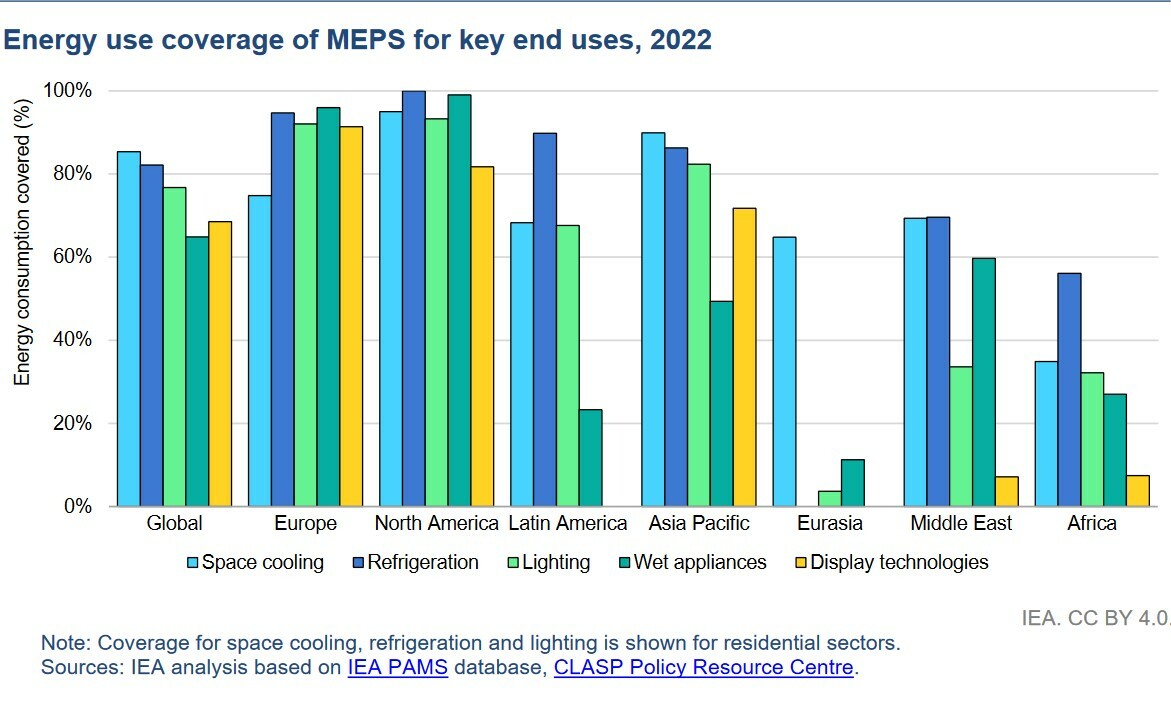Worldwide adoption of MEPS on the rise
Over 100 countries now use mandatory minimum energy efficiency performance standards or energy labels for the most common appliances, according to the IEA Energy Efficiency 2022 report.
According to the International Energy Agency (IEA), space and water heating are the largest energy consumers in buildings, responsible for almost half of energy demand in 2021. [1] However, air conditioning is experiencing the fastest growth, up 6.5% in 2021, compared with the year before.
More than 100 countries now use mandatory minimum energy performance standards (MEPS) and/or energy labels for the most common appliances, in recognition of their significant cost-effective energy saving potential and other benefits. However, energy policies are still absent in several emerging economies where ownership of appliances is rising rapidly. Additional or expanded standards and labelling schemes are under development in over 20 countries, mainly in Asia and Africa.
According to data from IEA and CLASP, over 80% of the energy used for air conditioners and refrigerators in the residential sector worldwide is covered by minimum standards (see figure below, where IEA uses the term “space cooling” for “air conditioning”). [1]

In the ASEAN (Association of Southeast Asian Nations) region, air conditioning is among the fastest growing end uses, with energy consumption expected to more than quadruple by 2040. This reflects the growing populations and rising incomes in relatively hot and humid climates. Policy action supporting the deployment of more efficient air conditioners, along with other measures such as the use of efficient fans and building envelope improvements, could help ASEAN member states reduce by over one third the projected energy use for air conditioning. The same actions would also reduce GHG emissions by over 55 Mt of CO2 in 2040, which, alongside decarbonisation of electricity supply, could bring CO2 emissions from air conditioning in the region below 2018 levels.
Besides improving the energy efficiency of air conditioners and fans, some countries in the region are also making efforts in district cooling. For example, in the Philippines, the Northgate Cyberzone district relies on district cooling to meet thermal comfort needs of over a dozen buildings and reduce the related annual electricity consumption by 39%. [1, 2]
The need for more stringent standards
All countries in the ASEAN region currently have some level of MEPS and labelling policy in place or under development for air conditioners. Despite these advances, considerable scope remains to increase the stringency of MEPS in the region. For example, in September 2022 the IEA noted that 100% of air conditioner models on the Indonesian market already complied with the new regulation when it came into force. As a result, the regulation had no effect in removing low-efficiency products. This is a missed opportunity to benefit from improved energy efficiency. It is estimated that implementation of robust appliance efficiency standards, energy pricing reforms and building energy codes and standards in Indonesia alone can help avoid a 225 TWh increase in electricity demand by 2050.
Sources
[1] IEA (2022), Energy Efficiency 2022, IEA, Paris https://www.iea.org/reports/energy-efficiency-2022 , License: CC BY 4.0
[2] https://www.districtenergyaward.org/northgate-district-cooling-system-northgate-philippines/
